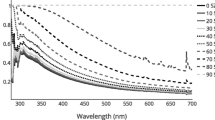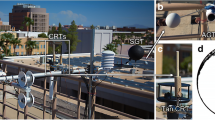Abstract
Whilst the measurement of radiation emissions from a surface is relativelystraightforward, correct interpretation and proper utilization of the informationrequires that the surface area `seen' be known accurately. This becomes non-trivialwhen the target is an urban surface, due to its complex three-dimensional form andthe different thermal, radiative and moisture properties of its myriad surface facets.The geometric structure creates shade patterns in combination with the solar beamand obscures portions of the surface from the sensor, depending on where it is pointing and its field-of-view (FOV). A model to calculate these surface-sensor-sun relations (SUM) is described. SUM is tested against field and scale model observations, and theoretical calculations, and found to perform well. It can predict the surface area`seen' by a sensor of known FOV pointing in any direction when placed at any pointin space above a specified urban surface structure. Moreover, SUM can predict theview factors of the roof, wall and ground facets `seen' and whether they are sunlit orshaded at any location and time of day. SUM can be used to determine the optimalplacement and orientation of remote sensors to study urban radiation emissions; ifthe facet temperatures are known or modelled it can calculate the average temperatureof the system, and it can determine the directional variation of temperature (anisotropy) due to any particular surface-sensor-sun geometric combination. Thepresent surface geometry used in SUM is relatively simple, but there is scope to makeit increasingly realistic.
Similar content being viewed by others
References
Ashdown, I.: 1994, Radiosity: A Programmer's Perspective, John Wiley and Sons Inc., 497 pp.
Baum, D. R., Rushmeier, H. E., and Winget, J. M.: 1989, 'Improving Radiosity Solutions through the Use of Analytically Determined Form Factors', Comput. Graph. 23, 325–334.
Caselles, V. and Sobrino, J. A.: 1989: 'Determination of Frost in Orange Groves from NOAA-9 AVHRR Data', Rem. Sens. Environ. 29, 135–146.
Caselles, V., Sobrino, J. A., and Coll, C.: 1992, 'A Physical Model for Interpreting the Land Surface Temperature Obtained by Remote Sensors over Incomplete Canopies', Rem. Sens. Environ. 39, 203–211.
Ellefsen, R.: 1990, 'Mapping and Measuring Buildings in the Canopy Boundary Layer in Ten U.S. Cities', Energ. Build. 15-16, 1025–1049.
Hottel, H. C. and Sarofim, A. F.: 1967, Radiative Transfer, McGraw-Hill, New York, 520 pp.
Iino, A. and Hoyano, A.: 1996, 'Development of a Method to Predict the Heat Island Potential Using Remote Sensing and GIS Data', Energ. Build. 23, 199–205.
Jackson, R. D., Reginato, R. J., Pinter, P. J. J., and Idso, S. B.: 1979, 'Plant Canopy Information Extraction from Composite Scene Reflectance of Row Crops', Appl. Optics 18, 3775–3782.
Johnson, R. B. and Branstetter, E. E.: 1974: 'Integration of Planck's Equation by the Laguerre-Gauss Quadrature Method', J. Optic. Soc. Amer. 64, 1445–1449.
Kimes, D. S. and Kirchener, J. A.: 1983, 'Directional Radiometric Measurements of Row-Crop Temperatures', Int. J. Rem. Sens. 4, 299–311.
Kimes, D. S., Holben, B. N., Tucker, C. J., and Newcomb, W. W.: 1984, 'Optimal Directional View Angles for Remote Sensing Missions', Int. J. Rem. Sens. 5, 887–908.
Kimes, D. S., Smith, J. A., and Link, L. E.: 1981, 'Thermal IR Exitance Model of a Plant Canopy', Appl. Optics 20, 623–632.
Myrup, L. O.: 1969, 'A Numerical Model of the Urban Heat Island', J. Appl. Meteorol. 8, 908–918.
Nichol, J. E.: 1998, 'Visualisation of Urban Surface Temperatures Derived from Satellite Images', Int. J. Rem. Sens. 19, 1639–1649.
Oke, T. R.: 1981, 'Canyon Geometry and the Nocturnal Urban Heat Island: Comparison of Scale Model and Field Observations', J. Climate 1, 237–254.
Roth, M., Oke, T. R., and Emery, W. J.:, 1989, 'Satellite-Derived Urban Heat Islands from Three Coastal Cities and the Utilization of Such Data in Urban Climatology', Int. J. Rem. Sens. 19, 105–115.
Schmid, H. P.: 1997, 'Experimental Design for Flux Measurements: Matching Scales of Observations and Fluxes', Agric. For. Meteorol. 87, 179–200.
Sobrino, J. A. and Caselles, V.: 1990, 'Thermal Infrared Radiance Model for Interpreting the Directional Radiometric Temperature of a Vegetative Surface', Rem. Sens. Environ. 33, 193–199.
Sobrino, J. A., Caselles, V., and Becker, F.: 1990, 'Significance of the Remotely Sensed Thermal Infrared Measurements Obtained over a Citrus Orchard', ISPRS J. Photogramm. Rem. Sens. 44, 343–354.
Soux, A.: 2000, Modelling Surface Structure and Temperature of Relevance to Remote Sensing of Cities, M.Sc. Dissertation, Geography, University of British Columbia, Vancouver, B.C., 101 pp.
Sutherland, R. A. and Bartholic, J. F.: 1977, 'Significance of Vegetation in Interpreting Thermal Radiation from a Terrestrial Surface', J. Appl. Meteorol. 16, 759–763.
Voogt, J. A.: 1995, Remote Sensing of Urban Surface Temperatures, Ph.D. Dissertation, University of British Columbia, Vancouver, B.C., Geography, University of British Columbia, 340 pp.
Voogt, J. A. and Oke, T. R.: 1997, 'Complete Surface Temperatures', J. Appl. Meteorol. 36, 1117–1132.
Voogt, J. A. and Oke, T. R.: 1998a, 'Effects of Urban Surface Geometry on Remotely-Sensed Surface Temperature', Int. J. Rem. Sens. 19, 895–920.
Voogt, J. A. and Oke, T. R.: 1998b, 'Radiometric Temperatures of Urban Canyon Walls Obtained from Vehicle Traverses', Theor. Appl. Climatol. 60, 199–217.
Author information
Authors and Affiliations
Additional information
An erratum to this article is available at http://dx.doi.org/10.1023/B:BOUN.0000027946.95842.e9.
Rights and permissions
About this article
Cite this article
Soux, A., Voogt, J.A. & Oke, T.R. A Model to Calculate what a Remote Sensor `Sees' of an Urban Surface. Boundary-Layer Meteorology 111, 109–132 (2004). https://doi.org/10.1023/B:BOUN.0000010995.62115.46
Issue Date:
DOI: https://doi.org/10.1023/B:BOUN.0000010995.62115.46




